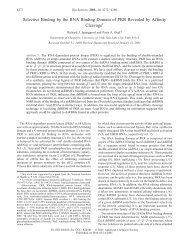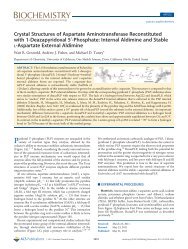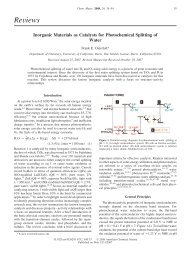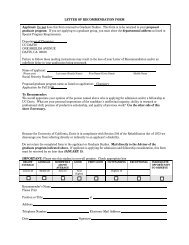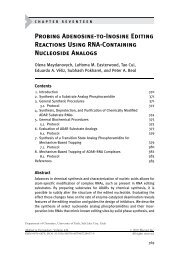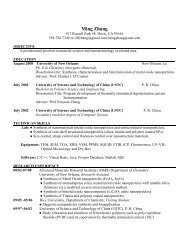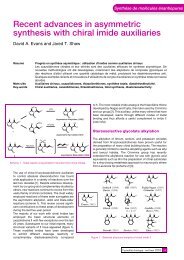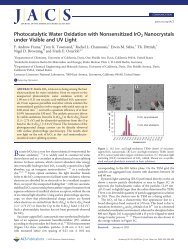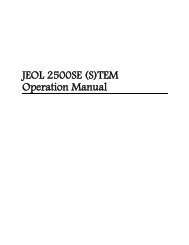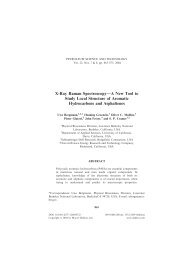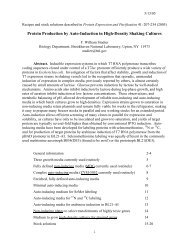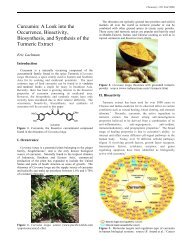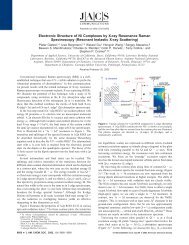K4Nb6O17-derived photocatalysts for hydrogen ... - UC Davis
K4Nb6O17-derived photocatalysts for hydrogen ... - UC Davis
K4Nb6O17-derived photocatalysts for hydrogen ... - UC Davis
You also want an ePaper? Increase the reach of your titles
YUMPU automatically turns print PDFs into web optimized ePapers that Google loves.
<strong>K4Nb6O17</strong>-<strong>derived</strong> <strong>photocatalysts</strong> <strong>for</strong> <strong>hydrogen</strong> evolution from water:<br />
Nanoscrolls versus nanosheets<br />
Michael C. Sarahan a,b , Elizabeth C. Carroll a , Mark Allen a , Delmar S. Larsen a ,<br />
Nigel D. Browning b,c , Frank E. Osterloh a,<br />
a Chemistry Department, University of Cali<strong>for</strong>nia, One Shields Avenue, <strong>Davis</strong>, CA 95616, USA<br />
b Chemistry and Materials Science Department, University of Cali<strong>for</strong>nia, One Shields Avenue, <strong>Davis</strong>, CA 95616, USA<br />
c Lawrence Livermore National Laboratory, 7000 East Avenue, Livermore, CA 94550, USA<br />
article info<br />
Article history:<br />
Received 17 April 2008<br />
Received in revised <strong>for</strong>m<br />
6 June 2008<br />
Accepted 10 June 2008<br />
Available online 14 June 2008<br />
Keywords:<br />
Nanosheets<br />
Nanoscrolls<br />
Exfoliation<br />
Photocatalysis<br />
Water splitting<br />
Hydrogen<br />
1. Introduction<br />
abstract<br />
The hexaniobate <strong>K4Nb6O17</strong> has been known <strong>for</strong> over 20 years as<br />
an active catalyst <strong>for</strong> methanol de<strong>hydrogen</strong>ation under ultraviolet<br />
(UV) irradiation [1]. From water the catalyst evolves <strong>hydrogen</strong> at<br />
low rates and oxygen at sub-stoichiometric rates, but stoichiometric<br />
H2/O2 evolution with quantum efficiencies of 5.3–20% is<br />
possible after modification with 0.1 wt% NiO [2–5] or after internal<br />
platinization [6]. The structure of <strong>K4Nb6O17</strong> consists of stacked<br />
asymmetrical Nb6O17<br />
4 layers (Fig. 1), which are composed of edgeand<br />
corner-shared NbO6 octahedra. Depending on layer orientation,<br />
stacking produces two kinds of potassium-filled interlayers,<br />
denoted as I and II [7]. It has been hypothesized that water<br />
reduction occurs in interlayer I and water oxidation at interlayer<br />
II, and that an electric field gradient originating from the uneven<br />
K + ion distribution on both sides of the sheets may assist in<br />
electron–hole separation [6,8]. To shed further light onto the<br />
photocatalytic mechanism and the location of the active sites, and<br />
to determine whether the layer interaction is a requirement <strong>for</strong><br />
the photocatalytic properties of <strong>K4Nb6O17</strong>, we have per<strong>for</strong>med<br />
photochemical studies on exfoliated niobate layers in water and in<br />
Corresponding author. Fax: +1530 752 8995.<br />
E-mail address: fosterloh@ucdavis.edu (F.E. Osterloh).<br />
0022-4596/$ - see front matter & 2008 Elsevier Inc. All rights reserved.<br />
doi:10.1016/j.jssc.2008.06.021<br />
ARTICLE IN PRESS<br />
Journal of Solid State Chemistry 181 (2008) 1681– 1686<br />
Contents lists available at ScienceDirect<br />
Journal of Solid State Chemistry<br />
journal homepage: www.elsevier.com/locate/jssc<br />
The layered hexaniobate <strong>K4Nb6O17</strong> is known as a photocatalyst <strong>for</strong> methanol de<strong>hydrogen</strong>ation and<br />
<strong>hydrogen</strong> evolution from water under ultraviolet (UV) light. Here we show that the activity is retained<br />
in propylammonium- (PA) or tetrabutylammonium- (TBA) stabilized H2K2Nb6O17 nanosheets and TBAstabilized<br />
H4Nb6O17 nanoscrolls that can be obtained by exfoliation of <strong>K4Nb6O17</strong> followed by cation<br />
exchange. The catalytic activity of the exfoliated systems is comparable to <strong>K4Nb6O17</strong>, with scrolls being<br />
most active in water, and PA sheets giving enhanced H2 rates due to sacrificial electron donor action of<br />
PA. Femtosecond absorption spectra <strong>for</strong> TBA scrolls and PA sheets exhibit broad features between 450<br />
and 700 nm due to trapped holes and electrons. Electron–hole recombination follows approximately<br />
second-order kinetics, with rates of decay similar <strong>for</strong> sheets and scrolls. In addition, catalysts were<br />
characterized with UV/vis and fluorescence spectroscopy and transmission electron microscopy.<br />
& 2008 Elsevier Inc. All rights reserved.<br />
aqueous methanol. Nanosheets that contain double niobate layers<br />
can be obtained as individual nanoparticles by reaction of<br />
K 4Nb 6O 17 with propylammonium (PA) hydrochloride [9]. Reaction<br />
with HNO3, on the other hand, followed by treatment with<br />
tetrabutylammonium (TBA) hydroxide produces TBA nanoscrolls,<br />
which contain niobate layers folded onto themselves [10]. Due to<br />
the folding, these nanoscrolls produce a new type of interlayer III,<br />
not represented in the structure of <strong>K4Nb6O17</strong> (Fig. 1), whereas the<br />
nanosheets contain only interlayers of type II. As we will show<br />
here, both sheets and scrolls are effective catalysts <strong>for</strong> H2<br />
evolution from water and aqueous methanol, with overall<br />
activities modulated by the morphology and stacking of the<br />
nanosheets, and by the surfactants that stabilize them. Optical<br />
measurements suggest a reduced bandgap of the scrolls resulting<br />
from bending of the niobate layer, and femtosecond transient<br />
absorption measurements reveal differences in the excited state<br />
dynamics in the two systems that suggest scrolls support a greater<br />
number of trapped electrons than sheets.<br />
2. Experimental<br />
Optical measurements were per<strong>for</strong>med in standard quartz<br />
cuvettes using a Jobin-Ivon Fluoromax-P fluorimeter. UV/vis<br />
spectra were collected using an Ocean Optics DH2000 light
1682<br />
source and an HR2000 CG-UV-NIR spectrometer. A Fisher<br />
Scientific Marathon 21000 centrifuge at 13750 rpm was employed<br />
<strong>for</strong> centrifugation. Transmission electron micrographs were<br />
obtained on a Philips CM-12 instrument at 120 kV acceleration<br />
potential. Scanning transmission electron micrographs were<br />
obtained on a JEOL JEM2500SE instrument at 200 kV acceleration<br />
potential. Ultrasonication was per<strong>for</strong>med <strong>for</strong> o5 min using a 90 W<br />
ultrasonic cleaner (Fisher Scientific, model FS 20).<br />
2.1. Potassium niobates<br />
Potassium hexaniobate, <strong>K4Nb6O17</strong>, was obtained by heating a<br />
shaken and pulverized mixture of potassium carbonate (3.157 g,<br />
30.57 mmol, Acros ACS Reagent grade) and niobium (V) oxide<br />
(8.127 g, 22.84 mmol, Acros 99.9% purity) <strong>for</strong> the stoichiometric<br />
3:2 m ratio [11]. The mixture was <strong>for</strong>med into pellets in a pellet<br />
press with 6.5 metric tons of <strong>for</strong>ce. The pellets were calcined at<br />
1100 1C <strong>for</strong> 48 h in alumina crucibles. The resulting yellowish<br />
crystalline material was pulverized into a fine white powder using<br />
mortar and pestle. The structure of the material was confirmed by<br />
X-ray powder diffraction with a Scintag XDS-2000 powder X-ray<br />
diffractometer with a copper K-a line-focus tube.<br />
2.2. Propylammonium exfoliation<br />
Propylamine hydrochloride was obtained from Acros as 99+%<br />
purity. In all, 2.00 g (1.93 mmol) of the potassium niobate product<br />
(with 3 H2O) was stirred <strong>for</strong> 9 days with 3.88 g (40.60 mmol)<br />
propylamine hydrochloride in approximately 100 mL deionized<br />
(418 MO cm resistivity) water in an oil bath at 80 1C. The<br />
resulting mixture was centrifuged at 13750 rpm <strong>for</strong> 10 min. The<br />
supernatant was poured off, and the solid was redistributed with<br />
sonication in approximately 20 mL pure water. Centrifugation and<br />
redistribution were repeated twice more, <strong>for</strong> a total of three<br />
washes. The final solid was redistributed in 50 mL pure water with<br />
shaking and sonication. The concentration of sheets in the<br />
solution was measured by evaporating the solvent from 1.00 mL<br />
of the sample and weighing the remaining residue. The concentration<br />
of sheets was measured to be 24.67 mg/mL, which<br />
corresponds to 1.234 g K 2(PrNH 3) 2[Nb 6O 17] catalyst (62% yield,<br />
M ¼ 1028 g/mol).<br />
2.3. Tetrabutylammonium hydroxide exfoliation<br />
For the acid/TBA(OH) exfoliation, acid treatment of 2.0 g<br />
(1.93 mmol) potassium niobate trihydrate was carried out at<br />
room temperature <strong>for</strong> 5 days with 250 mL of 1.0 M (500 molar<br />
excess) sulfuric acid. The product was centrifuged after the fifth<br />
ARTICLE IN PRESS<br />
M.C. Sarahan et al. / Journal of Solid State Chemistry 181 (2008) 1681–1686<br />
Fig. 1. Synthesis of niobate nanosheets and nanoscrolls. The structure of <strong>K4Nb6O17</strong> and the tentative structure of niobate nanoscrolls are also shown.<br />
day, and washed with approximately 20 mL pure water three<br />
times. TBA hydroxide (40 wt% in water, Acros) was added to the<br />
wet solid in a 20:1 molar ratio (26.6 mL, 40.5 mmol). This mixture<br />
was stirred <strong>for</strong> 6 days, and the product was centrifuged and<br />
washed three times with approximately 20 mL water. 45 mL water<br />
was added to the precipitate, and the mix was shaken and<br />
sonicated until the solution was a homogeneous suspension. The<br />
concentration of sheets was measured to be 11 mg/mL, which<br />
corresponds to a total of 0.495 g (Bu4N)4[Nb6O17] (14% yield,<br />
M ¼ 1797 g/mol). Losses are likely due to nanosheets remaining in<br />
the supernatant that is poured off after each wash. Later<br />
exfoliations were per<strong>for</strong>med with longer centrifugation times<br />
during washing and attained higher yields. The scrolls have been<br />
observed in the supernatant visibly as white cloudiness in water,<br />
lacking the strong birefringence of the sheets. Observation of the<br />
supernatant and final redistributed sample by transmission<br />
electron microscopy (TEM) shows a thin rod-like structure, with<br />
edges showing the layers of the scrolls.<br />
2.4. Tetrabutylammonium sulfate ion exchange<br />
To prepare materials that differed only in morphology, and not<br />
in counterion, the PA exfoliated suspension was treated with 5%<br />
TBA sulfate. This solution was prepared by neutralizing TBA<br />
hydroxide with sulfuric acid, to a final pH of approximately 7.<br />
Approximately 5 mL of the PA exfoliated suspension was stirred<br />
with 50 mL of the 5% TBA sulfate <strong>for</strong> 30 min. This solution was<br />
rinsed and centrifuged three times, and tested <strong>for</strong> primary amine<br />
content using the ninhydrin test (5 mg ninhydrin in 50 mL water,<br />
pH made basic using 1.0 M KOH). After three treatments, the<br />
suspension tested negative <strong>for</strong> primary amines.<br />
2.5. Photolysis experiments<br />
Photochemical <strong>hydrogen</strong> generation experiments were carried<br />
out at 30 1C using a quartz flask that was exposed to the light of<br />
four low-pressure 175 W mercury lamps. The photon flux in the<br />
glass flask was found to be 5.370.4 10 16 photons/s <strong>for</strong> the<br />
250–500 nm spectral region of the lamps, as determined with<br />
ferrioxalate chemical actinometry. For catalytic measurements,<br />
the catalyst suspension (100 mg catalyst in 75 mL of water) was<br />
placed in a quartz flask. The flask was evacuated to 30 Torr and<br />
held there <strong>for</strong> 5 min. The flask was then filled with argon to<br />
atmospheric pressure and evacuated again. This was repeated <strong>for</strong><br />
a total of 3 evacuation/fill cycles. An online gas chromatograph<br />
system consisting of a Varian 3800 gas chromatograph with a<br />
thermal conductivity detector was used to analyze the gas in the<br />
reaction apparatus. An initial measurement was made to verify
the absence of <strong>hydrogen</strong>, oxygen and nitrogen. The <strong>hydrogen</strong><br />
content of the gas was checked periodically during exposure using<br />
the a<strong>for</strong>ementioned sampling procedure.<br />
2.6. Transient absorption<br />
The early photodynamics of charge carriers were characterized<br />
using a dispersed transient absorption spectrometer, which has<br />
been described in detail previously [12]. Suspensions of either<br />
sheets or scrolls in water and aqueous methanol were excited with<br />
300-nm, 200-fs pulses, and the photodynamics were monitored by<br />
the visible absorption of trapped charge carriers. Transient<br />
absorption experiments were also carried out on samples following<br />
6 h irradiation in the Hg-lamp photolysis chamber.<br />
3. Results and discussion<br />
TEM and scanning TEM were used to confirm the morphology<br />
of scrolls and sheets (Fig. 2). Cation exchange with TBA does not<br />
affect the sheet morphology as long as the exchange is carried out<br />
at room temperature and <strong>for</strong> periods not exceeding 30 min.<br />
Prolonged reaction does convert sheets into scrolls (see Supporting<br />
in<strong>for</strong>mation).<br />
During photoirradiation about 10% of the TBA sheets convert<br />
into scrolls (see Fig. 2C), a process that may be facilitated by the<br />
slightly elevated temperature (30 1C) in the photoreactor. Scrolls<br />
obtained by reaction of K 4Nb 6O 17 with acid/TBA(OH) are shown in<br />
Fig. 2B. The morphology resembles that described in earlier<br />
ARTICLE IN PRESS<br />
M.C. Sarahan et al. / Journal of Solid State Chemistry 181 (2008) 1681–1686 1683<br />
reports [10]. Remarkably, the diameter of the scrolls lies within a<br />
very narrow range of 2576 nm, as measured on TEM and STEM<br />
images. UV irradiation over 6 h leaves the scroll morphology<br />
mostly intact. Some observed bends and partial unrolling could<br />
be caused by the stirring and mechanical <strong>for</strong>ces during workup<br />
(Fig. 2D).<br />
Diffuse reflectance UV–visible spectra and emission spectra of<br />
the hexaniobate, and the nanoscrolls and nanosheets are shown in<br />
Fig. 3 and selected optical data are summarized in Table 1. It can<br />
be seen that the absorption edges vary with the morphology of<br />
the materials, and are increasingly shifted towards the visible in<br />
the order K 4Nb 6O 17onanosheetsonanoscrolls. Exchanging the<br />
counterion PA with TBA in the nanosheets causes a blue shift of<br />
8 nm that might be due to differences in nanosheet–surfactant<br />
interactions. Kudo and Sakata [13] have argued that protonation of<br />
the niobate converts surface NbQO bonds into weaker Nb–OH<br />
bonds, reducing the bandgap of the material. Replacing the<br />
<strong>hydrogen</strong> bond donor PA with an aprotic counterion should then<br />
increase the double bond character of the Nb–O bond, increasing<br />
the bandgap and blue-shifting the absorption edge.<br />
Based on absorption edges, bandgaps of the materials lie in the<br />
range of 3.44 (<strong>for</strong> PA sheets) to 3.56 eV (<strong>for</strong> K 4Nb 6O 17), which<br />
agrees with the literature value <strong>for</strong> <strong>K4Nb6O17</strong> [14]. For TBA scrolls<br />
the bandgap is reduced to 3.30 eV, possibly due to Nb–O–Nb bond<br />
weakening because of the bend of the niobate layers in the scrolls.<br />
When dispersed in water, all four materials also exhibit photoluminescence<br />
at room temperature under bandgap excitation. For<br />
K 4Nb 6O 17, the emission maximum is observed at 376 nm, which is<br />
blue-shifted from previous low temperature (77 K) measurements<br />
Fig. 2. TEM of (A) PA sheets and of (B) TBA scrolls. (C) STEM of TBA sheets after irradiation in aqueous methanol, and (D) TEM of TBA scrolls after irradiation in water.
1684<br />
on <strong>K4Nb6O17</strong> powders that give an emission maximum at 420 nm<br />
[13]. A reexamination of the fluorescence shows that if the<br />
emission spectrum is recorded at 77 K the emission peak does<br />
indeed occur at 415–420 nm (Supporting in<strong>for</strong>mation). A strong<br />
temperature dependence of the fluorescence is generally observed<br />
<strong>for</strong> indirect semiconductors. For nanosheets and nanoscrolls, the<br />
positions of the room temperature emission peaks are similar to<br />
K 4Nb 6O 17, indicating that the electronic structure of the niobate<br />
layers is maintained upon exfoliation. In the case of PA sheets, the<br />
emission is narrow compared to the other materials. It is possible<br />
that the narrowing of the peak is due to a reduction of midbandgap<br />
defects that are present in K 4Nb 6O 17, but that disappear<br />
upon exfoliation and purification of the sheets.<br />
All materials, especially the exfoliated ones, also exhibit a weak<br />
and broad emission peak at 600–800 nm, which can be assigned<br />
Fig. 3. Optical properties of Hg light source and catalysts. (A) Hg emission<br />
spectrum. (B) Diffuse reflectance UV–vis spectra of thin films of the catalysts after<br />
drying from aqueous solution. (C) Normalized emission spectra (l ex ¼ 275 nm,<br />
room temperature) of catalysts dispersed in water. The inset shows magnified<br />
region 550–800 nm.<br />
Table 1<br />
Optical properties<br />
ARTICLE IN PRESS<br />
M.C. Sarahan et al. / Journal of Solid State Chemistry 181 (2008) 1681–1686<br />
to radiative recombination of charge carriers trapped in mid-band<br />
states [12]. Variations in the shape and position of these peaks<br />
reflect structural differences in the NbO layers and in the layer<br />
environment as resulting from bending the niobate layers (scrolls<br />
versus sheets) and from differences in solvation (PA versus<br />
hydronium versus potassium ions).<br />
To determine the effect of the morphology of the niobate layers<br />
on the timescale of charge carrier dynamics, femtosecond<br />
transient absorption spectroscopy measurements were conducted<br />
on PA sheets and TBA scrolls. Both exhibit a broad visible transient<br />
absorption (Fig. 4A) that decays according to non-exponential,<br />
fluence-dependent dynamics, similar to what has been previously<br />
observed <strong>for</strong> <strong>K4Nb6O17</strong> [15] and HCa2Nb3O10 nanosheets [12].<br />
Trapped holes exhibit an absorption peak around 450 nm<br />
and trapped electrons absorb most strongly around 700 nm.<br />
These species decay through electron–hole recombination with<br />
approximately second-order kinetics as a result of nongeminate<br />
Fig. 4. (A) Transient spectrum 1 ps following 300 nm excitation of PA sheets and<br />
TBA scrolls in water. (B and C) Normalized kinetics at 450 and 700 nm.<br />
K 4Nb 6O 17 PA sheets TBA sheets TBA scrolls<br />
Absorption edge 348 nm/3.56 eV 360 nm/3.44 eV 352 nm/3.52 eV 375 nm/3.30 eV<br />
Emission maximum 376 nm/3.29 eV 371 nm/3.34 eV 380 nm/3.26 eV 372 nm/3.33 eV<br />
Emission width at half maximum 143 nm 110 nm 136 nm 134 nm
ecombination and higher-order relaxation processes. The initial<br />
transient spectra of TBA scrolls and PA sheets exhibit a difference<br />
in the absorption at l4550 nm in scrolls (Fig. 4A). The greater<br />
absorption of the scrolls can represent either a larger absorption<br />
Fig. 5. H 2 evolution data from 20%(vol) aqueous methanol (A) and from water (B).<br />
The inset in B shows data <strong>for</strong> PA sheets.<br />
Table 2<br />
Catalytic activity<br />
ARTICLE IN PRESS<br />
M.C. Sarahan et al. / Journal of Solid State Chemistry 181 (2008) 1681–1686 1685<br />
cross-section <strong>for</strong> trapped electrons as compared to sheets or a<br />
larger trapped electron population relative to the population of<br />
trapped holes. Analysis of the kinetics at 450 and 700 nm (Fig. 4B<br />
and C) supports the latter interpretation, considering that the rate<br />
of decay is inversely proportional to carrier population <strong>for</strong> secondorder<br />
kinetics. The intrinsic recombination rate of each material<br />
cannot be determined without knowledge of the number of<br />
excitons generated on an individual sheet or scrolls [12,16].<br />
However, within the uncertainty of exciton density associated<br />
with the large size-dispersion of these samples, our measurement<br />
indicates that the intrinsic recombination rates in sheets and<br />
scrolls are not significantly different.<br />
To determine the effect of morphology on catalytic H2<br />
evolution from water and aqueous methanol (20%), particle<br />
dispersions in the respective media were irradiated simultaneously<br />
with four 175 W low-pressure mercury lamps. H 2<br />
evolution curves and selected data are shown in Fig. 5 and<br />
Table 2. In aqueous methanol, all materials were found to steadily<br />
produce H2. After 6 h the total evolved amount of H2 was at least<br />
twice the molar amount of the catalysts, proving the catalytic<br />
nature of the process. Overall, we find the activity of the<br />
nanomaterials to be similar to the parent phase K 4Nb 6O 17, or<br />
slightly higher in the case of PA sheets. In these systems, methanol<br />
reduces the niobate in the excited state, which subsequently<br />
donates the electron to water [1]. The data show that exfoliation<br />
does not increase the activity of the niobate. That agrees with<br />
previous evidence <strong>for</strong> effective methanol penetration into the<br />
interlayer space of K 4Nb 6O 17 [17]. For PA sheets, the slightly<br />
higher activity is likely due to the presence of propylamine, which<br />
gets oxidized preferentially over methanol. Butylamine has been<br />
previously shown to be an effective electron donor under photocatalytic<br />
conditions [18,19]. As expected, when PA is substituted<br />
with TBA, the activity <strong>for</strong> H2 evolution is reduced and becomes<br />
comparable to that of <strong>K4Nb6O17</strong>.<br />
The involvement of PA in the redox reactions and its oxidation<br />
over long irradiation times (46 h) are further supported by<br />
transient absorption experiments of the sheets conducted be<strong>for</strong>e<br />
and after photolysis (Supporting in<strong>for</strong>mation). For freshly exfoliated<br />
PA sheets, the dynamics observed in both water and<br />
aqueous methanol solutions are indistinguishable, suggesting that<br />
on the nanosecond timescale methanol cannot compete with PA<br />
as a sacrificial donor. However, following photo-oxidation of PA<br />
after 6 h of irradiation, the carrier dynamics were found to be<br />
sensitive to methanol and sub-nanosecond hole scavenging was<br />
observed [12].<br />
From pure water, <strong>K4Nb6O17</strong> and all <strong>derived</strong> nanomaterials also<br />
evolve <strong>hydrogen</strong> gas under UV irradiation, although at a greatly<br />
diminished rate. Only PA sheets have nearly the same activity as<br />
observed in aqueous methanol, due to the sacrificial role of the<br />
<strong>K4Nb6O17</strong> (100 mg) PA sheets (100 mg) TBA sheets (100 mg) TBA scrolls (100 mg)<br />
20% methanol<br />
pH be<strong>for</strong>e (after) irradiation 10.05 (10.00) 9.00 (7.10) 9.44 (7.71) 10.25 (9.41)<br />
H2 (mmol) after 6 h 203.6 285.0 178.7 147.6<br />
H2 rate (mmol/h) 33.9 47.5 29.8 24.6<br />
QE (%) 3.24 4.53 2.84 2.35<br />
Water<br />
pH be<strong>for</strong>e (after) irradiation 10.42 (9.20) 9.32 (6.93) 9.19 (7.19) 9.88 (8.49)<br />
H2 (mmol) after 6 h 16.6 250.0 16.0 41.0<br />
H2 rate (mmol/h) 2.8 41.7 2.7 6.8<br />
QE (%) a<br />
0.28 3.97 0.25 0.65<br />
Catalyst amount: 100 mg, liquid volume: 75 mL.<br />
a QEs based on the photon flux across the full emission spectrum of Hg lamps. Actual QEs are higher, because catalysts only absorb o400 nm.
1686<br />
surface-adsorbed PA. As the PA is consumed, the H2 rate decreases<br />
with time. If PA is replaced with TBA, the activity becomes<br />
comparable to TBA scrolls and <strong>K4Nb6O17</strong>. For none of the materials<br />
could oxygen be detected in the headspace of the reactor. The lack<br />
of oxygen evolution has been noted <strong>for</strong> wide band semiconductors<br />
TiO 2 and niobates [5,20–22], and is generally attributed to either<br />
incomplete water oxidation leading to surface-bound <strong>hydrogen</strong><br />
peroxide, or rapid photoreduction and adsorption of oxygen<br />
generated by the oxidation of water. We previously observed that<br />
<strong>for</strong> Pt-modified HCa 2Nb 3O 10 nanosheets the accumulation of<br />
water oxidation products on the catalyst surface shuts down H2<br />
evolution after 9 h [23]. For TBA sheets and TBA scrolls, no<br />
significant drop in H2 evolution rate was observed <strong>for</strong> 30 h<br />
constant irradiation (Supporting in<strong>for</strong>mation), because water<br />
redox reactions are much slower in the absence of Pt cocatalysts.<br />
Comparing PA-free catalysts, one finds that the activity of TBA<br />
scrolls is nearly twice that of the TBA sheets and <strong>K4Nb6O17</strong>.<br />
This enhanced activity could be caused by several factors. First,<br />
it could be due to a bandgap reduction resulting from bending of<br />
the niobate layers. The reduced bandgap shifts the absorption<br />
edge into the visible, enabling better overlap with the 365 nm<br />
emission line in the Hg spectrum (Fig. 3A). Second, it could be due<br />
to a larger trapped electron population relative to the population<br />
of trapped holes, as indicated by the greater absorption in the<br />
500–700 nm region of the transient absorption spectrum. Excess<br />
electrons would be expected to promote water reduction. Third,<br />
due to their folding, scrolls contain interlayer III that is not present<br />
in either K 4Nb 6O 17 or TBA sheets. This configuration may be<br />
advantageous <strong>for</strong> water reduction.<br />
4. Conclusions<br />
In summary, we have shown that the catalytic activity of<br />
K 4Nb 6O 17 <strong>for</strong> photochemical H 2 evolution from water and aqueous<br />
methanol is preserved in pseudo-molecular fragments of the<br />
parent compound. This shows that exciton generation and water<br />
redox reactions in these systems are intra-layer processes that do<br />
not require the presence of a three-dimensional layer framework<br />
as present in the parent material. It also demonstrates that surface<br />
area is not the limiting factor in these catalysts. The activities of<br />
the nanoscale catalysts are affected by propylammonium, which<br />
acts as a sacrificial donor. For scrolls, the observed enhanced<br />
activity in water could be either due to the structural features of a<br />
new type of interlayer, due to a reduced bandgap from bending, or<br />
due to a larger trapped electron population, as suggested by<br />
transient absorption spectra. Apart from this, the intrinsic<br />
recombination rates in sheets and scrolls are not significantly<br />
different.<br />
ARTICLE IN PRESS<br />
M.C. Sarahan et al. / Journal of Solid State Chemistry 181 (2008) 1681–1686<br />
Acknowledgments<br />
This work was supported by an Energy Innovation Startup<br />
Grant of the Cali<strong>for</strong>nia Energy Commission (Osterloh), and by DoE<br />
grant DE-FG02-03ER46057 (Browning).<br />
Appendix A. Supporting in<strong>for</strong>mation<br />
Supplementary data associated with this article can be found<br />
in the online version at doi:10.1016/j.jssc.2008.06.021.<br />
References<br />
[1] K. Domen, A. Kudo, M. Shibata, A. Tanaka, K. Maruya, T. Onishi, J. Chem. Soc.<br />
Chem. Commun. (23) (1986) 1706–1707.<br />
[2] K. Sayama, A. Tanaka, K. Domen, K. Maruya, T. Onishi, Catal. Lett. 4 (3) (1990)<br />
217–222.<br />
[3] H.G. Kim, D.W. Hwang, J. Kim, Y.G. Kim, J.S. Lee, Chem. Commun. (12) (1999)<br />
1077–1078.<br />
[4] K. Sayama, A. Tanaka, K. Domen, K. Maruya, T. Onishi, J. Catal. 124 (2) (1990)<br />
541–547.<br />
[5] S. Tabata, H. Ohnishi, E. Yagasaki, M. Ippommatsu, K. Domen, Catal. Lett. 28<br />
(2–4) (1994) 417–422.<br />
[6] K. Sayama, A. Tanaka, K. Domen, K. Maruya, T. Onishi, J. Phys. Chem. 95 (3)<br />
(1991) 1345–1348.<br />
[7] M. Gasperin, M.T. Lebihan, J. Solid State Chem. 43 (3) (1982) 346–353.<br />
[8] K. Domen, in: M. Kaneko, I. Okura (Eds.), Photocatalysis Science and<br />
Technology, Springer, New York, 2002, pp. 261–278.<br />
[9] N. Miyamoto, H. Yamamoto, R. Kaito, K. Kuroda, Chem. Commun. (20) (2002)<br />
2378–2379.<br />
[10] G.B. Saupe, C.C. Waraksa, H.-N. Kim, Y.J. Han, D.M. Kaschak, D.M. Skinner,<br />
T.E. Mallouk, Chem. Mater. 12 (6) (2000) 1556–1562.<br />
[11] K. Nassau, J.W. Shiever, J.l. Bernstei, J. Electrochem. Soc. 116 (3) (1969)<br />
348–353.<br />
[12] E.C. Carroll, O.C. Compton, D. Madsen, D.S. Larsen, F.E. Osterloh, J. Phys. Chem.<br />
C 112 (7) (2008) 2394–2403.<br />
[13] A. Kudo, T. Sakata, J. Phys. Chem. 100 (43) (1996) 17323–17326.<br />
[14] Y.I. Kim, S.J. Atherton, E.S. Brigham, T.E. Mallouk, J. Phys. Chem. 97 (45) (1993)<br />
11802–11810.<br />
[15] A. Furube, T. Shiozawa, A. Ishikawa, A. Wada, K. Domen, C. Hirose, J. Phys.<br />
Chem. B 106 (12) (2002) 3065–3072.<br />
[16] G. Rothenberger, J. Moser, M. Gratzel, N. Serpone, D.K. Sharma, J. Am. Chem.<br />
Soc. 107 (26) (1985) 8054–8059.<br />
[17] Y. Ebina, A. Tanaka, J.N. Kondo, K. Domen, Chem. Mater. 8 (10) (1996)<br />
2534–2538.<br />
[18] K. Shimizu, Y. Tsuji, T. Hatamachi, K. Toda, T. Kodama, M. Sato, Y. Kitayama,<br />
Phys. Chem. Chem. Phys. 6 (5) (2004) 1064–1069.<br />
[19] K. Shimizu, S. Itoh, T. Hatamachi, T. Kodama, M. Sato, K. Toda, Chem. Mater. 17<br />
(20) (2005) 5161–5166.<br />
[20] A. Mills, G. Porter, J. Chem. Soc. Faraday Trans. I 78 (1982) 3659–3669.<br />
[21] K. Sayama, K. Yase, H. Arakawa, K. Asakura, A. Tanaka, K. Domen, T. Onishi,<br />
J. Photochem. Photobiol. A 114 (2) (1998) 125–135.<br />
[22] E. Yesodharan, S. Yesodharan, M. Gratzel, Sol. Energy Mater. 10 (3–4) (1984)<br />
287–302.<br />
[23] O.C. Compton, C.H. Mullet, S. Chiang, F.E. Osterloh, J. Phys. Chem. C 112 (15)<br />
(2008) 6202–6208.



